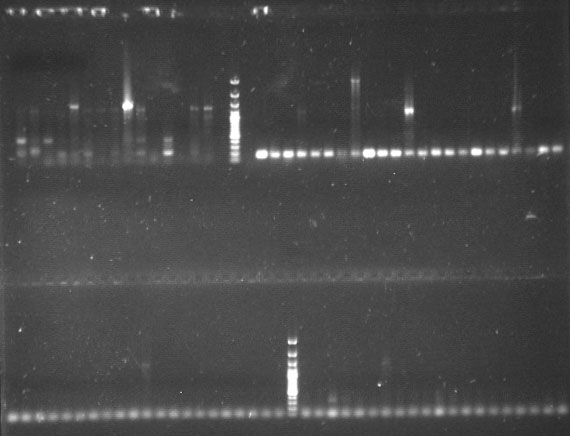Team:UNICAMP-Brazil/Notebooks/September 19
From 2009.igem.org
(→New biobricks - Third screening) |
|||
| (6 intermediate revisions not shown) | |||
| Line 6: | Line 6: | ||
====finO and finP's biobricks confirmation==== | ====finO and finP's biobricks confirmation==== | ||
| - | *<p style=”text-align:justify;”>Today we performed a PCR of each September 15th's minipreps samples, using the finO and finP designed primers, in order to confirm that our inserts are correctly contained in the plasmid vector. Unfortunately, our lab ran out of Taq Polymerase, and we were forced to | + | *<p style=”text-align:justify;”>Today we performed a PCR of each September 15th's minipreps samples, using the finO and finP designed primers, in order to confirm that our inserts are correctly contained in the plasmid vector. Unfortunately, our lab ran out of Taq Polymerase, and we were forced to use a home-made Taq, which efficiency is much lower than the industrialized one.</p> |
*<p style=”text-align:justify;”>Sadly, we weren't able to confirm finO and finP's biobricks, as our PCR's didn't amplified even a single fragment. However, that result may be a consequence of the home-made Taq usage, and we intend to repeat those PCR's with a trustable Taq.</p> | *<p style=”text-align:justify;”>Sadly, we weren't able to confirm finO and finP's biobricks, as our PCR's didn't amplified even a single fragment. However, that result may be a consequence of the home-made Taq usage, and we intend to repeat those PCR's with a trustable Taq.</p> | ||
''Marcelo'' | ''Marcelo'' | ||
| + | ====Cre-Recombinase + pSB1A3 ligation==== | ||
| + | *<p style=”text-align:justify;”>Once we digested Cre-Recombinase's insert and the vector with ''Xba''I and ''Spe''I restriction enzymes, we could perform the ligation between them, according to protocol [https://2009.igem.org/Team:UNICAMP-Brazil/Protocols/T4_DNA_Ligase Protocol 11].</p> | ||
| + | *<p style=”text-align:justify;”>Then, we transformed the ligation into electrocompetent ''E. coli'' cells, strain DH10B, accordin to protocol [https://2009.igem.org/Team:UNICAMP-Brazil/Protocols/Electroporation Protocol 3].</p> | ||
| + | *<p style=”text-align:justify;”>After being incubated at 37ºC for 1 hour, transformed cells were plated into solid LB-AMP media, and were grown at 37ºC for an O/N period.</p> | ||
| + | |||
| + | ''Víctor'' | ||
| + | |||
| + | ==''' YeastGuard '''== | ||
| + | |||
| + | ====New biobricks - Third screening==== | ||
| + | |||
| + | *<p style=”text-align:justify;”>The agarose gel of the 88 colony PCR showed that we have a big problem! A big screening like this should have shown some positive colonies. In order to make shorter primers and save some money we didn't include the ''EcoR''I and ''Spe''I sites at the adapters regions. This was our problem, the vector digested with ''Xba''I and ''Ste''I is able even to recircularize as to connect to the PCR products digested with the same enzymes. We will try to think in one strategy to avoid the recircularization.</p> | ||
| + | |||
| + | *<p style=”text-align:justify;”>There is still another problem we will face with this constructions: the part can insert in sense or antisense orientations, since ''Xba''I and ''Spe''I are cohesive!</p> | ||
| + | |||
| + | [[Image:20090922_confirm_PCRcolonia_todos1.jpg|400px|center]] | ||
| + | |||
| + | *<p style=”text-align:justify;”>We chose some few possible positive colonies to see the orientation of the part in the biofusion vector. We used forward vector's primer and reverse part's primer. If the part insert correctly there will be a fragment corresponding to its size and a little part of the vector. If the part insert in antisense orientation there will be no amplicon. We found no positive colonies. We realy need to improve our cloning strategy...</p> | ||
| + | |||
| + | ''Raíssa'' | ||
{{:Team:UNICAMP-Brazil/inc_rodape}} | {{:Team:UNICAMP-Brazil/inc_rodape}} | ||
Latest revision as of 02:50, 22 October 2009
| ||||||||||||||||||||||||||||||||||
 "
"















